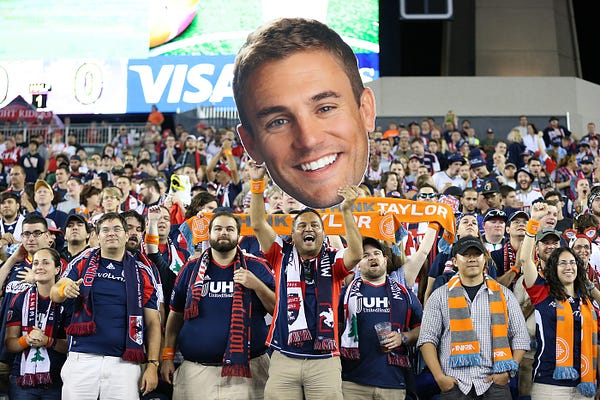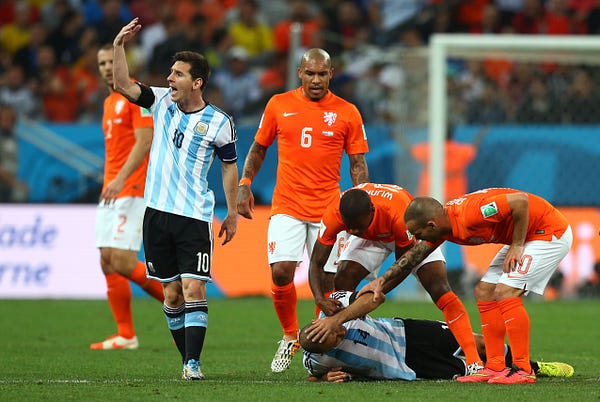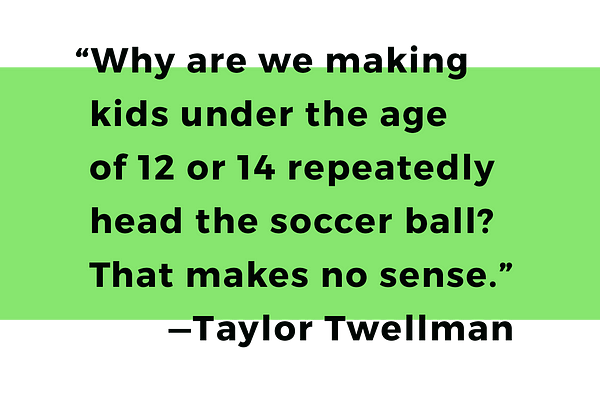What Happens When Soccer Bans Heading? – The Ringer – The Ringer (blog)
 It’s morning on a soccer field, somewhere in America. Two teams of 10-year-olds play a typical youth match, a constantly moving mass of arms and legs. There’s passing and shooting, goals and saves. It looks like soccer, except for one thing: There’s no heading. When the ball flies up into the air, the children control it with their chests, thighs, or feet, or they let it hit the ground. They don’t head the ball because it’s against the rules.
It’s morning on a soccer field, somewhere in America. Two teams of 10-year-olds play a typical youth match, a constantly moving mass of arms and legs. There’s passing and shooting, goals and saves. It looks like soccer, except for one thing: There’s no heading. When the ball flies up into the air, the children control it with their chests, thighs, or feet, or they let it hit the ground. They don’t head the ball because it’s against the rules.
It might look a little strange to the casual observer, used to watching Zlatan Ibrahimovic launch himself into the air and clash with a center back to reach a ball 10 feet off the ground, but ask yourself a question: Knowing everything we now know about head injuries, if we were going to invent the sport of soccer today, would we allow heading?
The growing anti-header movement within the game suggests not. In late 2015, as part of its Recognize to Recover program, the United States Soccer Federation announced the U.S. Soccer Concussion Initiative 2016, which bans heading for children 10 and under (and limits heading for children aged 11 to 13 to 30 minutes per week). In England, the Professional Footballers’ Association wants the country’s youth leagues to adopt measures similar to those currently applied in the U.S. If it happens in England, experts think Western Europe will soon follow.
We’re still not sure that it is, but even if purposeful heading of the ball were perfectly safe, the unintended consequences — inevitable things like head-to-head, head-to-shoulder, and head-to-ground contact — will lead to concussions. I put the question to Taylor Twellman, a former United States national team striker who had his career cut short due to concussions and has become an ardent concussion awareness spokesman. His answer: “I think if it was invented today, heading would be outlawed until pretty much the professional level, the paid players.”
Heading won’t ever go away. It’s too intertwined into the fabric that makes soccer the world’s most popular sport to disappear completely. At the youth level, vocal critics fear that if children don’t learn how to head the ball when they are young, they never will. Plus, it’s going to be nearly impossible to stamp out heading completely — even if we could get information to every youth team in every corner of the globe, there’s no way to ensure coaches won’t teach heading. Yet, from a safety standpoint, it’s dangerous and unnecessary to have kids with still-developing brains heading the ball hundreds of times. There’s a growing tension between the old-school, “rub some dirt on it and get back out there” traditionalists and a newer, more progressive group that’s focused on concussion awareness across all sports, not just soccer. Ever so slowly, the latter group is becoming the loudest voices on the field.
The future of soccer might look more like the American youth game than it ever has before.

 The laws of the game, first written down in England in the 1860s, have never outlawed heading the ball. (Early matches might have been played with actual human heads, which brings a whole new meaning to the term “head-to-head contact.”) Heading, however, was not popular. The balls were heavy to begin with and prone to becoming water-logged, which led to frequent head and neck injuries. One magazine from 1958 reported on “Football’s corridors full of punch-drunk players.”
The laws of the game, first written down in England in the 1860s, have never outlawed heading the ball. (Early matches might have been played with actual human heads, which brings a whole new meaning to the term “head-to-head contact.”) Heading, however, was not popular. The balls were heavy to begin with and prone to becoming water-logged, which led to frequent head and neck injuries. One magazine from 1958 reported on “Football’s corridors full of punch-drunk players.”
As technology improved and the balls got lighter, heading became a more routine practice. One of the most famous headers occurred during the 1970 World Cup in Mexico. The tournament, broadcast in color for the first time, featured a Brazilian squad stacked with Pelé, Carlos Alberto, Gérson, Jairzinho, Rivelino, and Tostão; it’s considered one of the best, if not the best, teams of all time. Rain the night before the final softened the turf, slowing the slick-moving Brazilians in their face-off against Italy. In the 18th minute, midfielder Roberto Rivelino served the ball across the face of goal. Pelé, just 5-foot-8, rose up over a defender and headed the ball past diving Italian goalkeeper Enrico Albertosi. If the diminutive star could score with his head, anyone could.
As the game has become more athletic since the days of Pelé, heading has only gained prominence. It’s an effective way to score on a cross into the box or off a set piece, an attacker rising above the defender or finding space between two center backs, then slamming the ball into the back of the net with the forehead. A header requires less technical ability than a 30-yard strike, often rewarding the brave rather than the skilled. Otherwise average footballers like Andy Carroll make millions and find themselves the subject of columns due to their heading prowess. Abby Wambach became an American hero after scoring in the 122nd minute against Brazil in the 2011 FIFA Women’s World Cup. John Brooks matched that heroic feat three years later against Ghana.
Heading is sort of ridiculous and frequently impractical — it’s much easier to control a ball with one’s foot — but there aren’t many other options when the ball is airborne. If a player is willing to stick his head where his opponent won’t, his team will gain an advantage — and that’s where things start to get dangerous.

 The discussion surrounding whether heading leads to concussions in soccer is not a new one. As far back as 1996, U.S. Soccer conducted a study in which it compared MRIs of players on the men’s national team with athletes from a track club. The results, published in The American Journal of Sports Medicine, showed that “there was no difference between them,” according to Dr. Bert Mandelbaum, who has been the U.S. men’s physician since 1991 and is also Major League Soccer’s assistant medical director. “The conclusion coming from that was that it was not the purposeful heading [that was a problem] but if any athlete — a track athlete or a soccer player — had a concussion, it was a problem,” Mandelbaum said.
The discussion surrounding whether heading leads to concussions in soccer is not a new one. As far back as 1996, U.S. Soccer conducted a study in which it compared MRIs of players on the men’s national team with athletes from a track club. The results, published in The American Journal of Sports Medicine, showed that “there was no difference between them,” according to Dr. Bert Mandelbaum, who has been the U.S. men’s physician since 1991 and is also Major League Soccer’s assistant medical director. “The conclusion coming from that was that it was not the purposeful heading [that was a problem] but if any athlete — a track athlete or a soccer player — had a concussion, it was a problem,” Mandelbaum said.
In other words, concussions are bad, no matter how they are sustained.
Plenty of scholarship has picked up on the headers-and-concussions-in-soccer theme since Mandelbaum’s study. Between 1998 and 2017, articles appeared in journals as varied as the Acta Neuropathol, The American Journal of Sports Medicine, EbioMedicine, JAMA, Journal of Athletic Training, Radiology, and Sports Med. That’s just a partial list.
Generally, these studies find that soccer should be concerned about concussions and chronic traumatic encephalopathy (CTE), a degenerative brain disease found in those who have suffered repeated blows to the head. The specific role that heading plays in causing concussions, however, is less clear. At least a few studies indicate that when a player heads the ball correctly — often called “purposeful heading”: when a player strikes the ball with their forehead and uses the entire upper body to propel themselves at the ball — there’s little risk of suffering a concussion because the concussive forces aren’t strong enough. Other studies show that the majority of concussions come from physical contact between two players, things like head-to-head, head-to-elbow, and head-to-ground contact, rather than head-to-ball. According to Dr. Michael Lipton, who is a professor of radiology and of psychiatry and behavioral sciences at the Albert Einstein College of Medicine and who conducted one such study: “Banning heading might not be the most effective way to limit concussion.”
Except, even if proper head-to-ball contact doesn’t result in many — or any — concussions, the act of attempting a header creates situations where head injuries become inevitable.
“Anytime you launch yourself, get off the pitch or the field, you’re increasing your risk. And concussion is no different,” said Dr. George Chiampas, U.S. Soccer’s chief medical officer. “[When we were considering a heading ban at the youth level,] what we looked at is if we can decrease that incident, naturally we can decrease the incidence of concussion. If we can keep players from colliding, from jumping into the air, from falling to the ground, from hitting each other, especially at these younger ages when some may be more developed than others, some may have skill sets that others don’t, and some may be able to protect themselves that others don’t.”

The decision to ban heading at the youth level came in part as a response to a 2014 class-action lawsuit filed in a U.S. district court in California that charged “FIFA, U.S. Soccer and the American Youth Soccer Organization with negligence in treating and monitoring head injuries,” according to The New York Times. But it also stemmed from increased awareness about concussions in the general public, and lobbying by former national team players including Brandi Chastain, Cindy Parlow Cone, and Taylor Twellman, and organizations like former professional wrestler Christopher Nowinski’s Concussion Legacy Foundation.
The ban on heading for children 10 and under could be the beginning of increased restrictions. Nowinski argues that it should extend to older age groups. “I still think it’s better for the game if you restrict it up to 14,” he said. Others agree with him, their cases bolstered by studies showing the danger of concussions and other brain trauma.
Plus, head injuries that don’t qualify as full-on concussions can still have a lasting impact.
“It’s becoming more established that the sub-concussive impacts do change the way your brain functions and could eventually lead to permanent damage,” Nowinski said. Research in sports like hockey and football backs up this statement. While we don’t know if heading can cause these sub-concussive impacts, we don’t know that they can’t. And the non-head-to-ball collisions that come from attempting a header certainly carry the risk of sub-concussive injuries.
Conversations about headers are happening all over the world, and no one is sure exactly where they’ll stop, for a few reasons. The biggest sticking point is that, at the highest level, heading the ball is a fundamental part of soccer. In order to enact stricter rules and convince the right people, decision-makers need to see more studies detailing the dangers of heading the ball. They also need more information about how, if at all, eliminating headers decreases the rate of concussions, and more information about the relationship between heading and brain trauma. They need, in short, more knowledge, and while organizations from U.S. Soccer to universities around the world are actively producing studies, more work needs to be done.

 The combination of research, good intentions, lawsuits, and awareness is what brought about U.S. Soccer’s current stance: heading banned for U-11s and restricted for the 11- to 13-year-old age group.
The combination of research, good intentions, lawsuits, and awareness is what brought about U.S. Soccer’s current stance: heading banned for U-11s and restricted for the 11- to 13-year-old age group.
No longer are scientists the only ones focused on head injuries and concussions. Awareness has broken through into the mainstream media consciousness as well, especially in the United States. This is partially due to the trials and tribulations of the NFL (and the issue’s subsequent forays into pop culture, like the Will Smith vehicle Concussion). Due to the reporting around gridiron football, the public is talking about concussions, CTE, and head injuries like they never have before, and so it’s only natural that soccer would fall under the microscope as well.

It’s also a function of high-profile moments in big games. During the semifinal of the 2014 World Cup, Javier Mascherano smashed his head into the noggin of the Netherlands’ Georginio Wijnaldum. Mascherano looked dazed but returned to the match. During the Major League Soccer playoffs in November of last year, Montreal Impact defensive midfielder Hernán Bernardello clashed with Jozy Altidore in a nasty collision. In January, Hull midfielder Ryan Mason suffered a fractured skull in a match against Chelsea. Players like Twellman and Alecko Eskandarian retired due to concussion-related symptoms, then became outspoken advocates for concussion awareness. They found a general public more educated and willing to listen than ever.
While many advocates like Twellman and Nowinski would like to see the age raised — “Why are we making kids under the age of 12 or 14 repeatedly head the soccer ball? That makes no sense,” Twellman said — there’s resistance on multiple fronts. “When U.S. Soccer announced its initiative and I put it out on Twitter, I had death threats about changing our youth and not creating Messis,” the former New England Revolution star said. Some people were not pleased.
Ian Barker, the National Soccer Coaches Association of America’s director of coaching education, agrees with Twellman — to a certain extent. While the NSCAA offers an interactive course, Get aHEAD Safely in Soccer, designed to help coaches implement the USSF restrictions and teach proper heading technique, Barker has concerns about atrophying or unlearned skills. “If we wish to develop competitive players for a domestic and world stage throughout our age groups, if we have very, very prohibitive protocols in regard to heading and the rest of the world doesn’t, there’s a long-term implication for our competitive relevance in certain technical aspects of the game,” he said.

Therein lies the tension with heading. It’s important for kids to learn how to do something that is a fundamental part of soccer. But that thing is also a danger to their health. However, good teams don’t head the ball very much. Barcelona’s tiki-taka playing style is not characterized by its creative use of headers. If the average U-11 squad spends the 30 minutes they formerly spent on headers doing something else like passing drills or developing technical skills, might that be a good thing in the long run? If America is going to win a World Cup, it doesn’t need more 6-foot-4 center backs who can head the ball; it already has plenty. No, it needs more Landon Donovans with speed, vision, and technical ability, and it needs more Clint Dempseys, who can score with any part of their body. Reminder: The best American player is 5-foot-8.
As for what’s the next step, Chiampas, the U.S. Soccer medical officer, said that U.S. Soccer is working collaboratively with two research institutions to gather information about the U-11 initiative.
When I asked if he thought that the age would ever increase, he demurred.
“I think time and research and more information will direct that,” he said. “I don’t know if I can predict that.” He argued that there were easier, more effective methods to alleviating the negative effects of concussions. U.S. Soccer has a Recognize to Recover protocol that focuses in part on head and brain injuries. The program gives instructions on how players and coaches can identify concussions and the steps they need to go through to recover from one. Simply getting players, coaches, and teams to follow the procedures would eliminate many of the problems players face. According to Chiampas, only 50 percent of concussions are reported, much less treated.
This approach to head injuries and concussions also represent an opportunity for MLS and U.S. Soccer to take a lead in world soccer and provide a model for other leagues. It’s impossible to prevent them entirely, and MLS protocols continue to evolve, but the progress is encouraging. When the English Premier League added in-game concussion rules in 2014 following a notable Hugo Lloris concussion, player safety came second. Instead, the reasoning focused on limiting liability. “Clubs need to be aware that if they make mistakes and something tragic happens to a player after their manager has over-ruled the medic then it’s the club and the manager who become liable,” Dr. Ian Beasley, the Football Association’s senior doctor, told the Daily Mail. “For smaller clubs that could break them financially. We have to make sure they understand what the consequences are.”
American soccer is being more proactive, both in on-field changes to the game and in bringing attention to the issue. On April 21 and 22, the USSF, MLS, and the National Women’s Soccer League hosted a concussion summit in New York City called “Head Injury in Soccer: From Science to the Field.” It was one of the first major events focused specifically on concussions in soccer, taking place six months after a similar meeting in Berlin that brought together concussion experts from different sports. The goal was to share information and disseminate best practices for concussion prevention and treatment.
While U.S. Soccer is still struggling to gain its footing as a world-soccer power, they are trying to lead the way when it comes to player safety. Soccer is a newer sport here with less tradition compared with Europe and South America, which leads to slightly more malleable opinions and rules.

“I wouldn’t be surprised if we changed where heading was allowed for older athletes [high school and above] as well,” Nowinski said. “I think we’ll come to a point in the next 10 years where heading isn’t allowed outside the boxes.”
Right now, banning headers in high school and college outright sounds like sacrilege, but think about a decade from now. Getting rid of them outside the box wouldn’t change the game in a fundamental way, while it would do a great deal to limit concussions and other injuries that stem from airborne collisions. If research continues to show that soccer players develop CTE and other syndromes, parents will grow increasingly concerned, which will spur the momentum for change. A lawsuit served as a major catalyst for the U-11 initiative, after all.
After a generation or two of kids grow up in a world where heading is limited, it might not be as strange for it to be removed from increasingly higher levels. Sports progress. Baseball lowered the height of the pitcher’s mound. Hockey added helmets. The NBA instituted the dunk and installed the 3-point line. The NFL penalized certain hits. Virtually all leagues have concussion protocols.
Sometimes change means adding equipment or rules designed to protect players. Sometimes it’s about taking away something that probably shouldn’t have been there in the first place.





